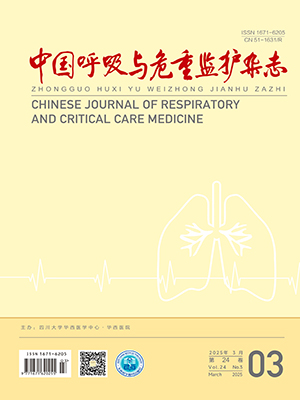Objective To evaluate the sonographic characteristics of peripheral focal inflammation of lung, and to improve the diagnosis and differential diagnosis potency of sonography for pulmonary peripheral lesions. Methods The sonogram of 44 patients with peripheral focal inflammation of lung were retrospectively analyzed and compared with the sonogram of other lesions. Independent variables included lesion’s margin, echotype, the secondary change of visceral pleura, the angulation of lesion’s inner surface and air bronchogram. Lesion’s nature was as dependent variable. The data was analyzed by Logistic regression analysis. Pathological results were confirmed by biopsy. Results The angulation of lesion’s inner surface and air bronchogramwere significant factors affecting the diagnosis of peripheral focal inflammation of lung( P lt;0. 01) . Compared to the pathological yield by biopsy, angulation of lesion’s inner surface being acute angle for diagnosis of peripheral focal inflammation of lung had an accuracy rate of 82. 6% , a sensitivity of 72. 7% , a specificity of 84. 7% , a positive predictive value of 51. 0% , and a negative predictive value of 93. 4%. Conclusions The acute angle of lesion’s inner surface and air bronchogram are sonographic characteristics of peripheral focal inflammation of lung. Bedside lung ultrasound is useful to the diagnosis of peripheral focal inflammation of lung.
Citation:
XU Yong,LI Xiuying,ZHU Ying,ZHU Xiaolin,ZHANG Sheng. Analysis of Sonographic Characteristics of Peripheral Focal Inflammation of Lung. Chinese Journal of Respiratory and Critical Care Medicine, 2010, 9(1): 15-18. doi:
Copy
Copyright © the editorial department of Chinese Journal of Respiratory and Critical Care Medicine of West China Medical Publisher. All rights reserved
| 1. |
Bouhemad B, Zhang M, Lu Q,et al. Clinical review: Bedside lung ultrasound in critical care practice. Crit Care,2007;11:205.
|
| 2. |
Parlamento S, Copetti R, Di Bartolomeo S. Evaluation of lung ultrasound for the diagnosis of pneumonia in the ED. Am J Emerg Med,2009,27:379-384.
|
| 3. |
杨钧,马大庆.肺内炎性肿块与周围型肺癌的CT鉴别诊断.中华放射学杂志,2002,36:235-239.
|
| 4. |
Gehmacher O, Mathis G, Kopf A,et al. Ultrasound imaging of pneumonia. Ultrasound Med Biol,1995,21:1119-1122.
|
| 5. |
陈敏华,严昆,张晖,等.超声对肺周边局限性炎性病变的诊断价值.中华超声影像学杂志,1999,8:295-298.
|
| 6. |
Reissig A,Kroegel C.Imaging 2005 -- ultrasound of the chest.Pneumologie,2005 ,59:477-484.
|
| 7. |
Yang PC.Ultrasound-guided transthoracic biopsy of peripheral lung,pleural,and chest wall lesions.J Thorac Imaging,1997,12:272-284.
|
| 8. |
Lichtenstein DA,Meziere G,Lascols N.Ultrasound diagnosis of occult pneumothorax.Crit Care Med,2005,33:1231-1238.
|
| 9. |
Reissig A,Kroegel C.Accuracy of transthoracic sonography in excluding post-interventional pneumothorax and hydropneumothorax.Comparison to chest radiography.Eur J Radiol,2005,53:463-470.
|
| 10. |
Reissig A,Kroegel C.Sonographic diagnosis and follow-up of pneumonia: a prospective study. Respiration,2007,74:537-547.
|
| 11. |
Copetti R,Cattarossi L.Ultrasound diagnosis of pneumonia in children.Radiol Med,2008,113:190-198.
|
| 12. |
Beckh S,Bölcskei PL,Lessnau KD.Real-time chest ultrasonography: a comprehensive review for the pulmonologist.Chest,2002,122:1759-1773.
|
- 1. Bouhemad B, Zhang M, Lu Q,et al. Clinical review: Bedside lung ultrasound in critical care practice. Crit Care,2007;11:205.
- 2. Parlamento S, Copetti R, Di Bartolomeo S. Evaluation of lung ultrasound for the diagnosis of pneumonia in the ED. Am J Emerg Med,2009,27:379-384.
- 3. 杨钧,马大庆.肺内炎性肿块与周围型肺癌的CT鉴别诊断.中华放射学杂志,2002,36:235-239.
- 4. Gehmacher O, Mathis G, Kopf A,et al. Ultrasound imaging of pneumonia. Ultrasound Med Biol,1995,21:1119-1122.
- 5. 陈敏华,严昆,张晖,等.超声对肺周边局限性炎性病变的诊断价值.中华超声影像学杂志,1999,8:295-298.
- 6. Reissig A,Kroegel C.Imaging 2005 -- ultrasound of the chest.Pneumologie,2005 ,59:477-484.
- 7. Yang PC.Ultrasound-guided transthoracic biopsy of peripheral lung,pleural,and chest wall lesions.J Thorac Imaging,1997,12:272-284.
- 8. Lichtenstein DA,Meziere G,Lascols N.Ultrasound diagnosis of occult pneumothorax.Crit Care Med,2005,33:1231-1238.
- 9. Reissig A,Kroegel C.Accuracy of transthoracic sonography in excluding post-interventional pneumothorax and hydropneumothorax.Comparison to chest radiography.Eur J Radiol,2005,53:463-470.
- 10. Reissig A,Kroegel C.Sonographic diagnosis and follow-up of pneumonia: a prospective study. Respiration,2007,74:537-547.
- 11. Copetti R,Cattarossi L.Ultrasound diagnosis of pneumonia in children.Radiol Med,2008,113:190-198.
- 12. Beckh S,Bölcskei PL,Lessnau KD.Real-time chest ultrasonography: a comprehensive review for the pulmonologist.Chest,2002,122:1759-1773.




